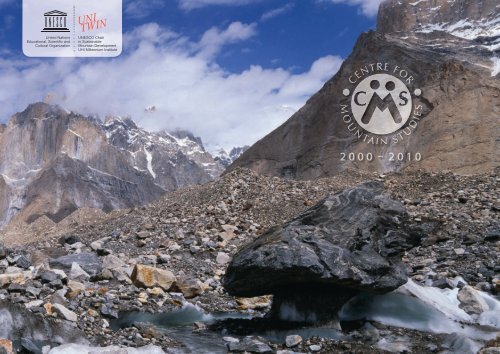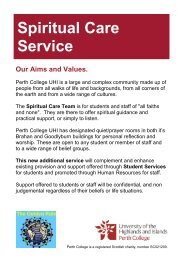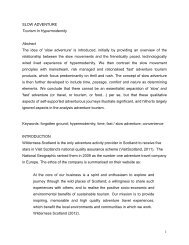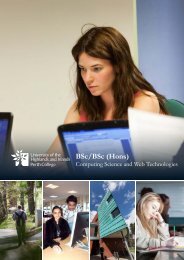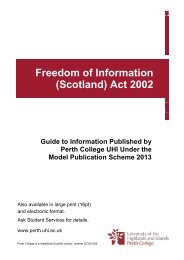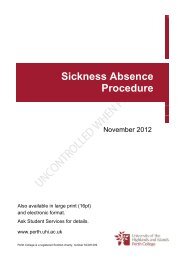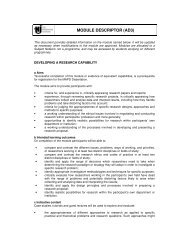UNESCO Chair in Sustainable Mountain Development UHI ...
UNESCO Chair in Sustainable Mountain Development UHI ...
UNESCO Chair in Sustainable Mountain Development UHI ...
You also want an ePaper? Increase the reach of your titles
YUMPU automatically turns print PDFs into web optimized ePapers that Google loves.
United Nations<br />
Educational, Scientific and<br />
Cultural Organization<br />
<strong>UNESCO</strong> <strong>Chair</strong><br />
<strong>in</strong> Susta<strong>in</strong>able<br />
Mounta<strong>in</strong> <strong>Development</strong><br />
<strong>UHI</strong> Millennium Institute<br />
2 0 0 0 – 2 0 1 0
1<br />
IntroductIon<br />
this document celebrates the tenth anniversary of the centre for Mounta<strong>in</strong> Studies (cMS), which was established at Perth college uHI on<br />
1 August 2000. the follow<strong>in</strong>g pages summarise the themes on which cMS staff and research students have worked over the last decade and lists<br />
key publications. As a preface, I would like to take this opportunity to provide a personal reflection on the orig<strong>in</strong>s of the cMS and some of the<br />
highlights of the past decade, and to thank some of the people who have helped it to grow and prosper.<br />
Mounta<strong>in</strong>s have been an important part of my life s<strong>in</strong>ce my parents first took me to<br />
Snowdonia when I was five and, when I was seven, to the Swiss Alps, where I remember<br />
look<strong>in</strong>g up at the green colour of a cave <strong>in</strong> the snout of a glacier. In my teens, rock-climb<strong>in</strong>g<br />
and mounta<strong>in</strong>eer<strong>in</strong>g were a passion that led to a gap year <strong>in</strong> Zambia as an outward Bound<br />
<strong>in</strong>structor, conclud<strong>in</strong>g with climb<strong>in</strong>g Kilimanjaro – still the highest place I have been. S<strong>in</strong>ce<br />
my Master’s degree at the university of calgary, with research <strong>in</strong> Banff national Park, mounta<strong>in</strong><br />
environments and the people who live <strong>in</strong> and visit them have also been my professional focus.<br />
For my Phd at the university of colorado, I undertook a comparative study of policies relat<strong>in</strong>g<br />
to forests <strong>in</strong> the Swiss Alps and colorado rockies: the beg<strong>in</strong>n<strong>in</strong>g of an <strong>in</strong>ternational scientific<br />
career which cont<strong>in</strong>ued as a post-doctoral fellow at the national center for Atmospheric<br />
research, where my ma<strong>in</strong> focus moved away from mounta<strong>in</strong>s to the human dimensions of<br />
global change. Subsequently, climate change cont<strong>in</strong>ued to be my focus at the university<br />
of oxford where, after a few years, I was fortunate to receive fund<strong>in</strong>g to start a mounta<strong>in</strong><br />
programme and organized the first of many conferences of mounta<strong>in</strong> scientists. However,<br />
oxford is far from the mounta<strong>in</strong>s, so when I was <strong>in</strong>vited to validate a course on susta<strong>in</strong>able<br />
development at uHI, I was glad to discover that a higher education <strong>in</strong>stitute with the word<br />
‘Highlands’ <strong>in</strong> its name needed to develop its research capacity on mounta<strong>in</strong> issues.<br />
A key question was where <strong>in</strong> the uHI network to establish such a capacity: Mike Webster, then<br />
Pr<strong>in</strong>cipal of Perth college uHI, was very welcom<strong>in</strong>g; and the Millennium commission and<br />
Perth and K<strong>in</strong>ross council provided some <strong>in</strong>itial fund<strong>in</strong>g. And so the cMS was born.<br />
A year later, I was <strong>in</strong>cluded <strong>in</strong> the uHI submission <strong>in</strong> Environmental Science to the uK-wide<br />
research Assessment. this submission achieved a rat<strong>in</strong>g of 4 – the highest <strong>in</strong> Scotland –<br />
ensur<strong>in</strong>g medium-term security of fund<strong>in</strong>g for the cMS. In 2002, the International Year of<br />
Mounta<strong>in</strong>s (IYM), it was natural that the cMS should organise the Scottish activities. Scottish<br />
natural Heritage (SnH) provided most of the funds necessary to employ a Project officer,<br />
Andrew Macpherson, and a broad partnership of conservation and recreational nongovernmental<br />
organisations (nGos) and public bodies provided further support for a diverse<br />
range of activities across Scotland. Scottish IYM activities raised awareness of the diverse ways<br />
<strong>in</strong> which mounta<strong>in</strong>s are important to Scots, and also raised the profile of the cMS, particularly<br />
through an <strong>in</strong>ternational conference organised with SnH and other conferences <strong>in</strong> London<br />
and Bishkek, Kyrgyzstan. 2002 was also the year <strong>in</strong> which Angela Paterson jo<strong>in</strong>ed the cMS as<br />
Adm<strong>in</strong>istrator, a ‘part-time’ role <strong>in</strong> which she has cont<strong>in</strong>ued for the same number of hours a<br />
week but with significantly <strong>in</strong>creas<strong>in</strong>g responsibilities, on which she always cheerfully delivers.<br />
tomas nilsson also jo<strong>in</strong>ed the cMS <strong>in</strong> 2002, and rhys Evans <strong>in</strong> 2003, both stay<strong>in</strong>g until 2004<br />
when they left for new horizons. In 2004, rob Mc Morran became our first Phd student,<br />
funded by Highlands and Islands Enterprise; he cont<strong>in</strong>ues today as a post-doctoral research<br />
associate who is a valued member of the team. I also concluded my role as coord<strong>in</strong>ator of the<br />
first overview of Europe’s mounta<strong>in</strong>s, for the European commission, with the publication of a<br />
substantial report after two years’ work. And, after three years’ preparation, the first students<br />
began to study on our on-l<strong>in</strong>e MSc <strong>in</strong> Manag<strong>in</strong>g Susta<strong>in</strong>able Mounta<strong>in</strong> development; ten have<br />
now graduated from the course with a full MSc, and n<strong>in</strong>e with Postgraduate certificates and<br />
diplomas.<br />
2005 was a year of growth, challenge, and change. clive Bowman and cróna o’Shea jo<strong>in</strong>ed<br />
us to work on the Spatialnorth project, funded by the European commission’s northern<br />
Periphery Programme (nPP) and a number of Scottish partners. In october, we were the ma<strong>in</strong><br />
organisers of an <strong>in</strong>ternational conference on global change <strong>in</strong> mounta<strong>in</strong> regions at Horsecross,<br />
Perth’s new conference centre/concert hall and, at the end of the year, we moved <strong>in</strong>to the<br />
purpose-built offices (for which both the Millennium commission and the Scottish Fund<strong>in</strong>g<br />
council were important donors) where we rema<strong>in</strong>. the staff of the centre grew aga<strong>in</strong> <strong>in</strong> 2006,<br />
with the arrival of Jeremy Milne and, for six months, Miriam Macchi from Switzerland. the<br />
year ended with good f<strong>in</strong>ancial news on a number of fronts: from the European commission<br />
for our <strong>in</strong>volvement <strong>in</strong> the 6th Framework EuroMArc project, on quality mounta<strong>in</strong> foods,<br />
and for a preparatory project for a new nPP project (clim-AtIc); and, most importantly, from<br />
Henry Angest, who very generously agreed to support a major project, <strong>in</strong>clud<strong>in</strong>g four doctoral<br />
studentships, on ‘Susta<strong>in</strong>able Estates for the 21st century’. the arrival of the Phd students –<br />
Pippa Wagstaff, Jayne Glass, Annie McKee, and Amanda calvert – <strong>in</strong> September 2007 was very<br />
welcome. Almost all the available space <strong>in</strong> the cMS was now taken; though both cróna and<br />
Jeremy left dur<strong>in</strong>g the year for new positions.
In 2008, clive took on the major responsibility of runn<strong>in</strong>g the clim-AtIc project on community<br />
adaptation to climate change; the largest project supported by the nPP, with partners and<br />
activities <strong>in</strong> F<strong>in</strong>land, Greenland, norway, Scotland and Sweden. rob successfully defended his<br />
Phd and worked on the EuroMArc project, as well as teach<strong>in</strong>g on the MSc; and J<strong>in</strong> Park jo<strong>in</strong>ed<br />
us to work on MSc course development and delivery and a number of projects. All of these<br />
activities, as well as the ‘estates’ Phds, cont<strong>in</strong>ued <strong>in</strong>to 2009; and at the end of the year, catal<strong>in</strong>a<br />
Munteanu, from romania (via Austria), jo<strong>in</strong>ed us to beg<strong>in</strong> our <strong>in</strong>volvement <strong>in</strong> a new 7th<br />
Framework project, mounta<strong>in</strong>.trIP (transform<strong>in</strong>g research Into Practice). the cMS also ga<strong>in</strong>ed<br />
greater prom<strong>in</strong>ence with the establishment of the unESco chair <strong>in</strong> Susta<strong>in</strong>able Mounta<strong>in</strong><br />
development, the first unESco chair <strong>in</strong> Scotland.<br />
2010 has been a year to celebrate. the highlight was <strong>in</strong> September: the <strong>in</strong>ternational<br />
conference on ‘Global change and the World’s Mounta<strong>in</strong>s’, aga<strong>in</strong> at Horsecross, which attracted<br />
450 people from 60 countries, mak<strong>in</strong>g it the largest <strong>in</strong>ternational science conference ever held,<br />
with more than twice as many people as for the conference <strong>in</strong> 2005. It stretched everyone <strong>in</strong><br />
the cMS, and the enthusiastic additional staff we hired, christiane nitsch and Karen Wright,<br />
to the limit: the result was widespread agreement that it was a very successful conference<br />
<strong>in</strong> many ways, and that we should organise another <strong>in</strong> 2015! the cMS team also expanded<br />
<strong>in</strong> 2010. In January, calum Macleod jo<strong>in</strong>ed us as deputy director, tak<strong>in</strong>g over some of my<br />
responsibilities, <strong>in</strong>clud<strong>in</strong>g the MSc, and soon brought <strong>in</strong> a project on the Land reform Act,<br />
funded by the Scottish Parliament. In May, our first visit<strong>in</strong>g fellow, Fiona Mackenzie from<br />
carleton university, canada, jo<strong>in</strong>ed us until the end of the year, to conduct research on land<br />
reforms <strong>in</strong> croft<strong>in</strong>g communities. In June, deborah davies jo<strong>in</strong>ed the clim-AtIc project, and<br />
spent most of the next four months visit<strong>in</strong>g projects from Greenland to F<strong>in</strong>land to produce<br />
case studies which were presented at the f<strong>in</strong>al conference <strong>in</strong> norway <strong>in</strong> october. In July, diana<br />
Borowski jo<strong>in</strong>ed us from Germany (via Poland) to start work on a new project funded by the<br />
European observation network for territorial development and cohesion (ESPon). And also<br />
<strong>in</strong> September, two weeks before the conference, the European Environment Agency published<br />
the latest state-of-the-art report on Europe’s mounta<strong>in</strong>s, which I had been coord<strong>in</strong>at<strong>in</strong>g for<br />
three years.<br />
over ten years, all of these activities – as well as many more, detailed <strong>in</strong> these pages – mean<br />
that the cMS is now recognised <strong>in</strong> Scotland and Europe, and around the world, as a significant<br />
and valued actor <strong>in</strong> mounta<strong>in</strong> research and knowledge exchange. the key element to this<br />
success has been the staff and doctoral students of the cMS, whom I should thank for their<br />
commitment and work of the highest quality. I would also like to thank my successive<br />
Pr<strong>in</strong>cipals at Perth college uHI – Mike Webster, Mandy Exley, and thomas Moore – for their<br />
encouragement and flexibility. there are also very many others who have provided support<br />
<strong>in</strong> different ways, particularly the Steer<strong>in</strong>g Group of the IYM <strong>in</strong> Scotland, the Advisory Group<br />
of the ‘estates’ project, and the representatives of the very diverse range of organisations<br />
that have provided fund<strong>in</strong>g for projects and events. F<strong>in</strong>ally, I would like to specifically<br />
thank six <strong>in</strong>dividuals: Alan Blackshaw, who <strong>in</strong>troduced me to uHI – the essential first step<br />
towards found<strong>in</strong>g the cMS; Henry Angest, for f<strong>in</strong>anc<strong>in</strong>g what will, I hope, be regarded as a<br />
landmark study on estates; Frank Gaskell, for <strong>in</strong>volv<strong>in</strong>g me <strong>in</strong> the world of European mounta<strong>in</strong><br />
policies and politics; Lt. col. John Moncreiff for contribut<strong>in</strong>g both to our new offices and to a<br />
scholarship for an MSc student from Bulgaria; col<strong>in</strong> Prior, for provid<strong>in</strong>g the photographs for<br />
this document; and my wife, randi Kv<strong>in</strong>ge, for her love and patience, especially on the many<br />
occasions when I am away from home. one def<strong>in</strong><strong>in</strong>g characteristic of most mounta<strong>in</strong> societies<br />
is plann<strong>in</strong>g and work<strong>in</strong>g <strong>in</strong> partnership; I believe that this exemplifies the cMS and that, with<br />
this <strong>in</strong> m<strong>in</strong>d, we will cont<strong>in</strong>ue to prosper and to undertake and – at least as importantly –<br />
communicate high-quality research to the benefit of mounta<strong>in</strong> people and their environments<br />
all around the world.<br />
Professor Mart<strong>in</strong> Price<br />
director, centre for Mounta<strong>in</strong> Studies<br />
chairholder, unESco chair <strong>in</strong> Susta<strong>in</strong>able<br />
Mounta<strong>in</strong> development<br />
2
3<br />
GEnErAtInG And IntEGrAtInG KnoWLEdGE<br />
over the past ten years, together with many partners, the cMS has been <strong>in</strong>volved <strong>in</strong> applied<br />
research projects, often with an important knowledge exchange component, at three scales:<br />
Europe; the northern Periphery of Europe, which extends from Greenland to F<strong>in</strong>land and as far<br />
south as the Highlands and Islands of Scotland; and Scotland.<br />
Europe: Characteris<strong>in</strong>g the mounta<strong>in</strong>s<br />
Mounta<strong>in</strong>s cover 36% of Europe’s area and are home to 17% of its population. they are of vital<br />
importance to all Europeans for at least four ma<strong>in</strong> reasons. First, they are ‘water towers’; they<br />
provide a high proportion of the cont<strong>in</strong>ent’s water, especially <strong>in</strong> summer, which is important<br />
as a source of hydro-electricity and for agriculture. Second, they are centres of diversity, both<br />
biological and cultural. Most of Europe’s ‘biological hotspots’, <strong>in</strong> terms of both total numbers<br />
of species and numbers of endemic species (those with very restricted distributions) are <strong>in</strong><br />
mounta<strong>in</strong> areas, and 15% of Europe’s mounta<strong>in</strong> area has been designated as national parks,<br />
nature reserves, and other types of protected areas. Mounta<strong>in</strong>s are also the home of many of<br />
Europe’s ethnic m<strong>in</strong>orities, with specific cultures and traditions. third, these mounta<strong>in</strong>s provide<br />
many varied opportunities for recreation and tourism, often l<strong>in</strong>ked to their natural and cultural<br />
heritage. F<strong>in</strong>ally, mounta<strong>in</strong> systems – ecological, hydrological, and human – are particularly<br />
sensitive to environmental change. the impacts of climate change are already evident<br />
throughout Europe’s mounta<strong>in</strong>s, and both gradual changes and extreme events deriv<strong>in</strong>g from<br />
climate change are likely to have significant consequences both <strong>in</strong> the mounta<strong>in</strong>s and across<br />
the cont<strong>in</strong>ent.<br />
All of these issues have been addressed <strong>in</strong> the first two comprehensive evaluations of<br />
Europe’s mounta<strong>in</strong>s, both coord<strong>in</strong>ated by Mart<strong>in</strong> Price: the first for the European commission’s<br />
directorate-General for regional development – with nordregio, the nordic centre for<br />
Spatial development, and 20 other partners from across Europe – published <strong>in</strong> 2004; and the<br />
second for the European Environment Agency – with the European topic centre for Land use<br />
and Spatial Information <strong>in</strong> Spa<strong>in</strong> and its partners <strong>in</strong> Austria, the netherlands, and romania –<br />
published <strong>in</strong> 2010. the first focused particularly on demographic and economic issues and<br />
policies for mounta<strong>in</strong> areas, with detailed analysis at the national level for the countries of the<br />
current European union, norway, and Switzerland. the second placed particular emphasis on<br />
ecosystem services (especially water and biodiversity), trends <strong>in</strong> land cover and uses, protected<br />
areas, and the impacts of climate change. this work is now be<strong>in</strong>g taken further by diana<br />
Borowski and Mart<strong>in</strong> Price <strong>in</strong> a two-year project funded by the European observation network
for territorial development and cohesion (ESPon) on ‘geographical specificities’; all the parts<br />
of the European union – such as mounta<strong>in</strong>s, sparsely-populated areas, and islands – which<br />
may be seen to have special characteristics which require particular types of support. In this<br />
project, the cMS is responsible for the work on mounta<strong>in</strong>s and on development possibilities<br />
l<strong>in</strong>ked to biodiversity and protected areas. All of these activities have placed the cMS <strong>in</strong> the<br />
forefront of analysis of Europe’s mounta<strong>in</strong> areas, provid<strong>in</strong>g crucial evidence to <strong>in</strong>form European<br />
union policies.<br />
European commission (2004) Mounta<strong>in</strong> areas <strong>in</strong> Europe: Analysis of mounta<strong>in</strong> areas <strong>in</strong> Eu<br />
Member States, acced<strong>in</strong>g and other European countries. report 2004: 1, nordregio, Stockholm.<br />
European Environment Agency (2010) Europe’s ecological backbone: recognis<strong>in</strong>g the true<br />
value of our mounta<strong>in</strong>s. European Environment Agency, copenhagen.<br />
Price, M.F. (2004) Europe’s mounta<strong>in</strong>s: Similarity and diversity. In Ó c<strong>in</strong>néide, M. (ed.) territorial<br />
cohesion: Meet<strong>in</strong>g new challenges <strong>in</strong> an Enlarged Eu, department of community, rural and<br />
Gaeltacht Affairs, Galway: 41-46.<br />
Price, M.F. and copus, A. (2002) A prelim<strong>in</strong>ary characterisation of the mounta<strong>in</strong> areas of Europe.<br />
Euromontana, Brussels.<br />
Price, M.F., Lysenko, I. and Gloersen, E. (2004) La délimitation des montagnes européennes/<br />
del<strong>in</strong>eat<strong>in</strong>g Europe’s mounta<strong>in</strong>s. révue de Géographie Alp<strong>in</strong>e/Journal of Alp<strong>in</strong>e research<br />
92(2): 61-86.<br />
Europe: Policies for quality mounta<strong>in</strong> foods<br />
Food and dr<strong>in</strong>k represent an essential characteristic of every culture; high-quality foods can<br />
offer important opportunities for support<strong>in</strong>g mounta<strong>in</strong> communities and their cultures<br />
and, often, the biological diversity of their local environments. However, there are many<br />
challenges to realis<strong>in</strong>g these opportunities along the entire food cha<strong>in</strong> from farmers to<br />
consumers, which may also <strong>in</strong>clude processors, retailers, and those <strong>in</strong>volved <strong>in</strong> market<strong>in</strong>g and<br />
tourism. Various policies, at all scales from the local to the global, can both support or h<strong>in</strong>der<br />
these processes. From 2007 to 2009, rob Mc Morran and Mart<strong>in</strong> Price were <strong>in</strong>volved <strong>in</strong> the<br />
EuroMArc (European Mounta<strong>in</strong> Agrofood products, retail<strong>in</strong>g and consumers) project, funded<br />
by the European commission’s 6th Framework Programme for research and development.<br />
Its aims were to <strong>in</strong>crease understand<strong>in</strong>g of the challenges of add<strong>in</strong>g value to foods produced<br />
<strong>in</strong> mounta<strong>in</strong> areas, particularly those represented by the partners <strong>in</strong> the project, from Austria,<br />
France, norway, romania, Scotland and Slovenia, where detailed research was undertaken;<br />
and to develop recommendations both to those <strong>in</strong> the food cha<strong>in</strong> and to policy-makers at all<br />
levels. rob Mc Morran’s ma<strong>in</strong> contribution was to review the diverse national and European<br />
policies <strong>in</strong> this field. the project’s results have been well-accepted, and have also become<br />
the basis for further policy development by the European commission, particularly through<br />
the efforts of Euromontana, the European multisectoral association for cooperation and<br />
development of mounta<strong>in</strong> territories, which coord<strong>in</strong>ated the EuroMArc project.<br />
Euromontana (2009) designation and promotion of mounta<strong>in</strong> quality food products <strong>in</strong> Europe:<br />
Policy recommendations. Euromontana, Brussels.<br />
Euromontana (2009) Guidel<strong>in</strong>es for the development, promotion and communication of<br />
mounta<strong>in</strong> foods. Euromontana, Brussels.<br />
Northern Periphery: Large-scale regional plann<strong>in</strong>g<br />
A key need identified <strong>in</strong> the two evaluations of Europe’s mounta<strong>in</strong>s is for better coord<strong>in</strong>ation<br />
and <strong>in</strong>tegration of the policies and activities of different <strong>in</strong>stitutions as a basis for susta<strong>in</strong>able<br />
development. In order to address this need <strong>in</strong> northern Europe, with a focus on spatial data<br />
and plann<strong>in</strong>g, the cMS was one of 13 partners <strong>in</strong> the 2005-7 Spatialnorth project, funded<br />
by the European commission’s northern Periphery Programme (nPP) and, <strong>in</strong> Scotland, the<br />
crofters commission, Forestry commission, Highlands and Islands European Partnership,<br />
Scottish council of Voluntary organisations, Scottish Environment Protection Agency, and<br />
Scottish Executive. other partners came from Västernorrland (Sweden), north Karelia (F<strong>in</strong>land)<br />
and East Iceland. In each region, partners assessed levels of policy coord<strong>in</strong>ation and evaluated<br />
case studies of policy development, to identify good practice. In Scotland, the case studies<br />
considered coastal management, transport, w<strong>in</strong>d farms, local plans and, across the Highlands<br />
and Islands, the use of spatial data and the degree of coord<strong>in</strong>ation between organisations<br />
<strong>in</strong> implement<strong>in</strong>g policies relat<strong>in</strong>g to biodiversity. clive Bowman and cróna o’Shea from the<br />
cMS also took a lead <strong>in</strong> research on the alignment of plans from European to local level and<br />
the use of ‘visions’ and targets <strong>in</strong> strategic plans. the lessons learned <strong>in</strong> all four partner regions<br />
were shared through meet<strong>in</strong>gs, study tours, conferences (the f<strong>in</strong>al conference was organised<br />
by the cMS), and a dedicated website with a ‘toolbox’ of good practices, available at www.<br />
spatialnorth.org and thus accessible to planners across all of Europe, as well as for teach<strong>in</strong>g.<br />
Bowman, c.d. (2006) An evaluation of spatial plann<strong>in</strong>g policy alignment <strong>in</strong> the Highlands and<br />
Islands. International Journal of Biodiversity Science and Management 2: 174-177.<br />
Bowman, c.d. (2008) Lessons from the Spatialnorth Project, Scottish Planner 123,<br />
(June 2008): 12.<br />
o’Shea, c.J. (2006) GIS and spatial data management: a tool to plann<strong>in</strong>g <strong>in</strong> the Highlands and<br />
Islands of Scotland. International Journal of Biodiversity Science and Management 2: 178-181.<br />
4
5<br />
Northern Periphery: Local adaptations to the impacts of climate change<br />
climate change is likely to br<strong>in</strong>g both challenges and opportunities to communities across<br />
Europe’s northern Periphery. At all levels from the European to the local, considerable<br />
attention has been paid to mitigat<strong>in</strong>g the impacts of climate change; much less on adapt<strong>in</strong>g<br />
to them. to address this gap, clive Bowman and partners from across the northern Periphery<br />
developed the clim-AtIc project, which has been the largest project funded by the nPP, which<br />
provided 60% of the total budget of €2.4 million; <strong>in</strong> Scotland, fund<strong>in</strong>g has been provided<br />
by the cairngorms national Park Authority, Forestry commission, Highlands and Islands<br />
Enterprise, and Hitrans. the cMS, with the support of the uHI Millennium Institute, is the lead<br />
partner; the 13 other partners are from F<strong>in</strong>land, Greenland, norway, Scotland, and Sweden.<br />
the project runs from March 2008 to April 2011.<br />
In each participat<strong>in</strong>g region, public sector and academic <strong>in</strong>stitutions, communities, and other<br />
stakeholders have undertaken a l<strong>in</strong>ked series of activities: a comprehensive review of the likely<br />
short- and long-term implications on communities; the development of ‘climate change<br />
vulnerability scenarios’ us<strong>in</strong>g climate change data and models, social change scenarios, and<br />
local knowledge and experience; identification of barriers and opportunities for communities<br />
to adapt to climate change, lead<strong>in</strong>g to ‘community climate change adaptation strategies’; and<br />
adaptation projects, which are on four themes – energy management, risk management and<br />
response, tourism, and transport. In Scotland, activities – all coord<strong>in</strong>ated by clive Bowman –<br />
<strong>in</strong>cluded three <strong>in</strong> cairngorms national Park, on wood fuel, an electric car for community use,<br />
and us<strong>in</strong>g mobile phone applications to provide <strong>in</strong>formation to tourists on alternative activities<br />
when snow sports are not possible; and one on river restoration and flood management <strong>in</strong><br />
Glen urquhart. the results of all of the activities <strong>in</strong> the five participat<strong>in</strong>g countries have been<br />
shared among stakeholders <strong>in</strong> the participat<strong>in</strong>g regions through a number of exchange visits<br />
and conferences, and are be<strong>in</strong>g brought together <strong>in</strong> the website www.clim-atic.org, which<br />
<strong>in</strong>cludes <strong>in</strong>formation <strong>in</strong> easily-accessible formats <strong>in</strong>clud<strong>in</strong>g podcasts <strong>in</strong> various regional<br />
languages, compiled by deborah davies. the website will be l<strong>in</strong>ked to national websites <strong>in</strong><br />
nPP countries to provide a long-term source of <strong>in</strong>formation available to anyone <strong>in</strong>terested <strong>in</strong><br />
climate change adaptation at the community scale, and is also one of the ma<strong>in</strong> resources for<br />
a short ‘tra<strong>in</strong> the tra<strong>in</strong>ers’ course developed dur<strong>in</strong>g the project and piloted <strong>in</strong> norway <strong>in</strong> early<br />
2011. clim-AtIc has been regarded as one of the nPP’s most effective projects, provid<strong>in</strong>g<br />
results which are valuable with<strong>in</strong> and beyond the northern Periphery, and its case studies<br />
are also be<strong>in</strong>g considered for <strong>in</strong>clusion <strong>in</strong> the European Environment Agency’s web-based<br />
Environmental Atlas of Europe. It is anticipated that many of the adaptation projects will<br />
cont<strong>in</strong>ue after clim-AtIc concludes.
Scotland: Susta<strong>in</strong>able estates after devolution<br />
Scotland’s uplands are characterised by a unique pattern of land ownership, with much of<br />
the land with<strong>in</strong> privately-owned estates. In recent decades, a number of estates have been<br />
purchased by non-governmental organisations (nGos) with conservation and recreation<br />
<strong>in</strong>terests. Follow<strong>in</strong>g Scottish devolution <strong>in</strong> 1999, one of the key pieces of legislation was<br />
the Land reform (Scotland) Act 2003, which facilitated the purchase of estates by local<br />
communities. However, as shown by a 2010 study led by calum Macleod of the cMS and<br />
other partners for the Scottish Parliament’s rural Affairs and Environment committee, the<br />
community right to Buy has been little used, due to the <strong>in</strong>frequency of eligible land com<strong>in</strong>g<br />
onto the market, its adm<strong>in</strong>istrative complexities, and a preference by community groups to<br />
conclude purchases outwith the Act if possible.<br />
S<strong>in</strong>ce 2007, the ma<strong>in</strong> <strong>in</strong>-house project at the cMS, generously funded by the Henry Angest<br />
Foundation, has considered ‘Susta<strong>in</strong>able estates for the 21st century’. It is the first major<br />
project to take an <strong>in</strong>tegrated look at estates <strong>in</strong> the Scottish uplands, and also goes beyond<br />
previous studies – all conducted before devolution – which generally looked at a narrow range<br />
of issues or focused on <strong>in</strong>dividual estates. Its primary objective is to understand the complex<br />
driv<strong>in</strong>g forces that <strong>in</strong>fluence large upland multi-functional estates, and how their owners and<br />
managers make decisions that permit them to ensure that their estates fulfill their diverse roles<br />
– which may <strong>in</strong>clude any comb<strong>in</strong>ation of field sports, agriculture, forestry, tourism, renewable<br />
energy, and property development – and promote susta<strong>in</strong>ability. to ensure the project’s<br />
on-the-ground and policy relevance, it has an advisory board with representatives from the<br />
Scottish Government, Scottish rural Property and Bus<strong>in</strong>ess Association (SrPBA), Scottish<br />
Environment L<strong>in</strong>k, cairngorms national Park Authority, and the Knoydart Foundation. the<br />
project comprises three Phd studies, supervised by Mart<strong>in</strong> Price, charles Warren (university of<br />
St. Andrews) and Alister Scott (Birm<strong>in</strong>gham city university) and a post-doctoral study.<br />
At the core of the project is the concept of susta<strong>in</strong>ability, and one of the Phd students, Jayne<br />
Glass, has focused primarily on the development of a ‘toolkit’ to monitor and assess progress<br />
towards this goal. the toolkit has been developed us<strong>in</strong>g an adapted ‘delphi’ approach,<br />
<strong>in</strong> which a panel of 19 academics, consultants, estate management and susta<strong>in</strong>ability<br />
professionals, policy makers and members of representative bodies have anonymously<br />
<strong>in</strong>teracted <strong>in</strong> a collaborative and participatory process. the commitment of these<br />
participants to the process, and their strong <strong>in</strong>terest <strong>in</strong> it, has been shown by their very<br />
high level of <strong>in</strong>volvement throughout four rounds over two years: 88%, far higher than<br />
usual for studies us<strong>in</strong>g similar approaches. the result<strong>in</strong>g toolkit has been piloted on two<br />
estates owned by nGos, and wide <strong>in</strong>terest has been expressed <strong>in</strong> its use on upland<br />
estates of various ownership types.<br />
two of the Phd studies focus on privately-owned estates. In 2008, the two students, Annie<br />
McKee and Pippa Wagstaff, designed a survey that the SrPBA k<strong>in</strong>dly distributed to its<br />
members, achiev<strong>in</strong>g a highly satisfactory 34% response rate from owners of estates cover<strong>in</strong>g a<br />
total of 1.7 million acres. this was the first major survey of private landowners s<strong>in</strong>ce the Land<br />
reform Act, and provides a detailed evidence base with regard to the highly diverse range of<br />
private estates. Subsequently, Annie conducted <strong>in</strong>-depth case studies on six estates which<br />
had been identified as show<strong>in</strong>g ‘good practice’ <strong>in</strong> facilitat<strong>in</strong>g susta<strong>in</strong>able rural communities <strong>in</strong><br />
and around their estates. Her two-to three-week stays on each estate, us<strong>in</strong>g a wide range of<br />
methods, have produced a very rich understand<strong>in</strong>g of the threats and opportunities fac<strong>in</strong>g<br />
both communities and landowners, and of the key role of landowners <strong>in</strong> the susta<strong>in</strong>ability of<br />
these communities, <strong>in</strong> particular through support<strong>in</strong>g both estate ‘bus<strong>in</strong>ess’ susta<strong>in</strong>ability to<br />
ma<strong>in</strong>ta<strong>in</strong> employment and community-generated entrepreneurship. one outcome of the<br />
research will be a series of good practice recommendations for mutually-beneficial landownercommunity<br />
partnerships. Pippa’s research addresses landowners’ motivations and perceptions<br />
of susta<strong>in</strong>ability on a dozen estates chosen from the results of the 2008 survey, us<strong>in</strong>g a range<br />
of complementary techniques to understand the difficult issues <strong>in</strong>volved <strong>in</strong> balanc<strong>in</strong>g the<br />
conflict<strong>in</strong>g demands of the environment with economic and social priorities. this research<br />
provides a rare <strong>in</strong>sight <strong>in</strong>to the ‘hearts and m<strong>in</strong>ds’ of those who ultimately control a significant<br />
proportion of the Scottish uplands.<br />
A fourth study, by rob Mc Morran, aims to assess the susta<strong>in</strong>ability of four large upland<br />
community-owned estates (Assynt, Knoydart, north Harris, South uist), focuss<strong>in</strong>g on the<br />
<strong>in</strong>teractions of community and external stakeholders <strong>in</strong> the process of community buyouts,<br />
the impacts of these buy-outs on the <strong>in</strong>volved communities, and the key issues and<br />
opportunities for such buy-outs, as envisaged when the Land reform Act was drawn up.<br />
All four studies should be completed <strong>in</strong> early 2011; there has already been wide <strong>in</strong>terest <strong>in</strong> the<br />
outcomes of the project as a whole, as shown by requests for brief<strong>in</strong>gs from local and Scottish<br />
government <strong>in</strong>stitutions, as well as representative bodies. A further means of dissem<strong>in</strong>ation<br />
will be a book to be edited by Jayne Glass and the three Phd supervisors, which will provide<br />
a synthesis based on the four studies. It is expected that the book will be published by an<br />
6
7<br />
academic publisher <strong>in</strong> 2012, and that this will establish a coherent and ‘state-of-the art’ picture<br />
of Scottish upland estates and provide an <strong>in</strong>put to future well-founded management and<br />
policy.<br />
Glass, J.H., Scott, A.S. and Price, M.F. (<strong>in</strong> press). develop<strong>in</strong>g a susta<strong>in</strong>ability assessment tool for<br />
upland estates. In: S.J. Marrs, S. Foster, c. Hendrie, E.c. Mackey, and d.B.A. thompson (eds.) the<br />
chang<strong>in</strong>g nature of Scotland. the Stationery office, Ed<strong>in</strong>burgh.<br />
Macleod, c., Braunholtz-Speight, t., Macphail, I., Flyn, d., Allen, S., and Macleod, d. (2010) Post-<br />
Legislative Scrut<strong>in</strong>y of the Land reform (Scotland) Act 2003. the Scottish Parliament.<br />
McKee, A.J. and Warren, c.r. (<strong>in</strong> press) the Scottish revolution? Evaluat<strong>in</strong>g the impacts of post<br />
devolution land reform, Scottish Geographical Journal.<br />
reed, M.S., Bonn, A., Slee, W., Beharry-Borg. n., Birch, J, Brown, I., Burt, t.P., chapman, d.,<br />
chapman, P.J., clay, G., cornell, S.J., Fraser, E.d.G., Glass, J., Holden, J., Hodgson, J.A., Hubacek,<br />
K., Irv<strong>in</strong>e, B., J<strong>in</strong>, n., Kirkby, M.J., Kun<strong>in</strong>, W.E., Moore, o., Moseley, d., Prell, c., Price, M.F., Qu<strong>in</strong>n, c.,<br />
redpath, S., reid, c., Stagl, S., Str<strong>in</strong>ger, L.c., termansen, M., thorp, S., towers, W., and Worrall, F.<br />
(2009) the future of the uplands. Land use Policy 26 Supplement 1: S204-216.<br />
Scotland: an <strong>in</strong>creas<strong>in</strong>g diversity of forest functions<br />
Across Europe’s mounta<strong>in</strong>s as a whole, forests are the predom<strong>in</strong>ant land cover, occupy<strong>in</strong>g 40%<br />
of the total area. though forests cover a far smaller proportion of Scotland’s mounta<strong>in</strong>s, twothirds<br />
of Scottish forests are <strong>in</strong> private ownership, much higher than the European average.<br />
nevertheless, as <strong>in</strong> many other mounta<strong>in</strong> areas, a central challenge is to manage forests for a<br />
diversity of uses. this emphasis on multi-functionality was the ma<strong>in</strong> focus of rob Mc Morran’s<br />
Phd research from 2004 to 2008, funded by Highlands and Islands Enterprise and supervised<br />
by Mart<strong>in</strong> Price and charles Warren (university of St. Andrews). the research focused on the<br />
forests of the cairngorms, and revealed four ma<strong>in</strong> types of constra<strong>in</strong>ts and opportunities:<br />
spatial fragmentation and <strong>in</strong>tegration with<strong>in</strong> and between estates; globalization, timber<br />
price, and market availability; the complexity of bureaucracy and potential for organisational<br />
<strong>in</strong>tegration; and unpredictability <strong>in</strong> social and natural systems. As many constra<strong>in</strong>ts appear to<br />
result from scale ‘mis-matches’ – spatially, temporally, and at the organisational level – a key<br />
recommendation was to match scales at the management, organizational and market levels.<br />
Similar challenges were recognised <strong>in</strong> two studies of forests <strong>in</strong> caithness and Sutherland,<br />
conducted for Forestry commission Scotland (FcS) <strong>in</strong> 2007 by Jeremy Milne and <strong>in</strong> 2009 by<br />
rob Mc Morran. the forests of this area are primarily coniferous plantations, many orig<strong>in</strong>ally<br />
planted to ga<strong>in</strong> tax benefits, and now reach<strong>in</strong>g harvestable age. However, the range of
enefits expected from forests has expanded, now <strong>in</strong>clud<strong>in</strong>g not only economic, but also<br />
social and environmental benefits. In particular, the Scottish Government has set a target of<br />
25% forest cover <strong>in</strong> Scotland by 2050. the two studies recognised this chang<strong>in</strong>g context, and<br />
the wide range of result<strong>in</strong>g opportunities, <strong>in</strong>clud<strong>in</strong>g the potential for the development of the<br />
regional woodfuel market, the expansion of native riparian and semi-natural woodland, and<br />
widespread forest restructur<strong>in</strong>g. the 2009 report was put out to consultation by FcS, and is<br />
now contribut<strong>in</strong>g to the debate on how to manage the area’s forests.<br />
Price, M.F. (2005) Forests <strong>in</strong> susta<strong>in</strong>able mounta<strong>in</strong> development. In Huber u.M.,<br />
Bugmann H.K.M. and reasoner, M.A. (eds.) Global change and Mounta<strong>in</strong> regions:<br />
An overview of current Knowledge. Spr<strong>in</strong>ger, dordrecht: 521-529.<br />
Mc Morran r. (2008) the opportunities and constra<strong>in</strong>ts for multifunctional forest management<br />
<strong>in</strong> the cairngorms region of Scotland. unpublished Phd thesis, uHI Millennium Institute.<br />
Mc Morran, r. (2008) Scale mis-matches <strong>in</strong> social-ecological systems: A case study of<br />
multifunctional forestry <strong>in</strong> the cairngorms region of Scotland. Aspects of Applied Biology 85:<br />
Shap<strong>in</strong>g a vision for the uplands: 41-48.<br />
Scotland: Game species and wild land<br />
the management of privately-owned mounta<strong>in</strong> land with the primary aim of hunt<strong>in</strong>g game<br />
species – deer and game birds, especially red grouse – is a particularly Scottish phenomenon<br />
which has led to very specific landscapes. the cMS has undertaken a number of studies <strong>in</strong> this<br />
context. the first were undertaken for the deer commission for Scotland by tomas nilsson<br />
and Mart<strong>in</strong> Price <strong>in</strong> 2004: a scop<strong>in</strong>g study on how to monitor the ‘diffuse’ impacts of deer <strong>in</strong> the<br />
‘wider countryside’, i.e., outside areas designated for nature conservation; and how different<br />
approaches to def<strong>in</strong><strong>in</strong>g hunt<strong>in</strong>g seasons <strong>in</strong> other European countries and north America<br />
might be relevant <strong>in</strong> Scotland. the results of this research <strong>in</strong>formed subsequent Scottish<br />
policy. More recently, <strong>in</strong> 2009, rob Mc Morran undertook an <strong>in</strong>-depth case study, funded<br />
by the Scottish countryside Alliance Environmental trust, of the benefits and impacts of the<br />
grouse shoot<strong>in</strong>g <strong>in</strong>dustry from the perspective of the community of tom<strong>in</strong>toul and Strathdon,<br />
around which grouse shoot<strong>in</strong>g is a common activity. the study found that nearly 20% of the<br />
people <strong>in</strong> the community directly depend on grouse shoot<strong>in</strong>g for their livelihood, while almost<br />
80% use the managed moors for recreation, work, or food.<br />
Another perspective – especially among non-hunt<strong>in</strong>g recreational users – on upland estates,<br />
<strong>in</strong>clud<strong>in</strong>g many that are managed primarily for hunt<strong>in</strong>g, is that they are ‘wild land’, with<br />
outstand<strong>in</strong>g scenery, important wildlife, and diverse opportunities for outdoor recreation.<br />
this complex concept refers especially to areas that are particularly remote and rugged, with<br />
little evidence of human <strong>in</strong>fluence – and therefore has contested recreational, ecological,<br />
and cultural dimensions. However, empirical <strong>in</strong>formation appropriate for manag<strong>in</strong>g these<br />
landscapes – concern<strong>in</strong>g their social, environmental, and economic benefits and opportunities<br />
– has been limited. In 2005-6, the cMS, <strong>in</strong> collaboration with the Scottish Agricultural college,<br />
was contracted by Scottish natural Heritage to provide a stronger basis for discussion and<br />
policy developments regard<strong>in</strong>g these landscapes. A key recommendation of the research, led<br />
by rob Mc Morran, was that specific criteria should be developed for wild landscapes with<strong>in</strong><br />
Scottish Government policy, and that a Scottish Landscape Strategy should be developed,<br />
tak<strong>in</strong>g due account of the multiple values of wilder areas. rob Mc Morran has subsequently<br />
been <strong>in</strong>volved <strong>in</strong> two studies led by the Wildland research centre (WrI) at the university of<br />
Leeds – on wild land <strong>in</strong> the cairngorms for the cairngorms national Park Authority <strong>in</strong> 2009;<br />
and on wild land <strong>in</strong> Europe for the Scottish Government <strong>in</strong> 2010 – and also organised a 2010<br />
workshop on ‘Scotland’s wild landscapes: new ways forward’, attended by 94 people. All of<br />
these activities have <strong>in</strong>formed Scottish policy development and implementation; it is likely that<br />
the work done <strong>in</strong> the cairngorms will <strong>in</strong>form the next national Park Plan.<br />
carver, S., comber, L., Fritz, S., Mc Morran, r., taylor, S. and Washtell, J. (2008) Wildness Study <strong>in</strong><br />
the cairngorms national Park. university of Leeds.<br />
comber, A., carver, S., Fritz, S., Mc Morran, r. Washtell, J. and Fisher, P. (2010) different methods,<br />
different wilds: Evaluat<strong>in</strong>g alternative mapp<strong>in</strong>gs of wildness us<strong>in</strong>g fuzzy McE. computers,<br />
Environment and urban Systems 34: 142–152<br />
Fisher, M., carver, S., Kun, Z, Mc Morran, r., Arrell, K. and Mitchell, G. (2010) review of the status<br />
and conservation of wild land <strong>in</strong> Europe. Scottish Government commissioned report.<br />
Mc Morran, r. (2009) red grouse and the tom<strong>in</strong>toul and Strathdon communities - the benefits<br />
and impacts of the grouse shoot<strong>in</strong>g <strong>in</strong>dustry from the rural community perspective; a case<br />
study of the Strathdon and tom<strong>in</strong>toul communities <strong>in</strong> the cairngorms national Park. the<br />
Scottish countryside Alliance Educational trust commissioned report.<br />
Mc Morran, r., Price, M.F. and McVittie, A. (2006) A review of the benefits and opportunities<br />
attributed to Scotland’s landscapes of wild character. commissioned report 194, Scottish<br />
natural Heritage, Inverness.<br />
Mc Morran, r., Price, M.F. and Warren, c.r. (2008) the call of different wilds: the importance of<br />
def<strong>in</strong>ition and perception <strong>in</strong> protect<strong>in</strong>g and manag<strong>in</strong>g Scottish wild landscapes. Journal of<br />
Environmental Plann<strong>in</strong>g and Management 51:177-199.<br />
8
ExcHAnGInG And uSInG KnoWLEdGE<br />
As noted above, all of the research done by the cMS <strong>in</strong> the past ten years has had an applied<br />
focus. While many of these activities have had an important element of knowledge exchange,<br />
the cMS – often work<strong>in</strong>g with partners – has also undertaken many activities <strong>in</strong> which<br />
knowledge exchange has been the ma<strong>in</strong> focus, at a diversity of scales from the globe to<br />
Scotland. over 2,000 people from all cont<strong>in</strong>ents have attended meet<strong>in</strong>gs organised by the<br />
cMS. In 2009, the global dimension of the activities of the cMS was recognised by unESco’s<br />
designation of a chair <strong>in</strong> Susta<strong>in</strong>able Mounta<strong>in</strong> development at the uHI Millennium Institute,<br />
with Mart<strong>in</strong> Price as the chairholder. Many of the activities described below, particularly with<br />
regard to <strong>in</strong>creas<strong>in</strong>g understand<strong>in</strong>g of global change <strong>in</strong> mounta<strong>in</strong> regions and education for<br />
susta<strong>in</strong>able mounta<strong>in</strong> development, fall with<strong>in</strong> the scope of the chair.<br />
Foster<strong>in</strong>g susta<strong>in</strong>able mounta<strong>in</strong> development<br />
Before establish<strong>in</strong>g the cMS, Mart<strong>in</strong> Price had collaborated with colleagues at the university<br />
of Bern, Switzerland, <strong>in</strong> a number of activities relat<strong>in</strong>g to susta<strong>in</strong>able mounta<strong>in</strong> development<br />
(SMd), beg<strong>in</strong>n<strong>in</strong>g with the <strong>in</strong>clusion of a chapter on this theme <strong>in</strong> ‘Agenda 21’, the plan of<br />
action from the rio Earth Summit <strong>in</strong> 1992, and cont<strong>in</strong>u<strong>in</strong>g with an overview document for the<br />
‘rio + 5’ meet<strong>in</strong>gs of the united nations commission on Susta<strong>in</strong>able development (uncSd)<br />
<strong>in</strong> 1997 and reports on specific themes presented to the uncSd for consideration at their<br />
subsequent annual meet<strong>in</strong>gs. the report for 2001 considered energy and transport, and that<br />
for 2002 considered appropriate policies and <strong>in</strong>struments to support SMd.<br />
2002 was the International Year of Mounta<strong>in</strong>s (IYM), which aimed to “promote the conservation<br />
and susta<strong>in</strong>able development of mounta<strong>in</strong> regions, thereby ensur<strong>in</strong>g the wellbe<strong>in</strong>g of both<br />
mounta<strong>in</strong> and lowland people.” At the global level, Mart<strong>in</strong> Price acted as editor-<strong>in</strong>-chief for<br />
the f<strong>in</strong>al global event of the year, the Bishkek Global Mounta<strong>in</strong> Summit <strong>in</strong> Bishkek, Kyrgyzstan,<br />
work<strong>in</strong>g with the united nations Environment Programme (unEP). this <strong>in</strong>cluded plann<strong>in</strong>g<br />
the structure and content of the Summit; manag<strong>in</strong>g the production, <strong>in</strong>clud<strong>in</strong>g a global<br />
e-consultation through the Mounta<strong>in</strong> Forum and peer review, of ten background papers<br />
by global experts, which were published <strong>in</strong> 2004 as a book by united nations university<br />
Press; and facilitat<strong>in</strong>g the Summit’s f<strong>in</strong>al declaration, which became the basis of a resolution<br />
by the un General Assembly. In Europe, the cMS, together with Scottish natural Heritage<br />
(SnH), organised a conference on ‘nature and people: conservation and management <strong>in</strong><br />
the mounta<strong>in</strong>s of northern Europe’, which attracted 282 participants, <strong>in</strong>clud<strong>in</strong>g 33 from<br />
overseas; the proceed<strong>in</strong>gs were published <strong>in</strong> 2005. Mart<strong>in</strong> Price also convened a conference<br />
on ‘Susta<strong>in</strong>able futures for the British uplands’ at the royal Geographical Society <strong>in</strong> London,<br />
attended by 130 people and result<strong>in</strong>g <strong>in</strong> a widely-cited brief<strong>in</strong>g paper.<br />
In Scotland, IYM activities were organised by Andrew Macpherson, hired by the cMS as Project<br />
officer with fund<strong>in</strong>g ma<strong>in</strong>ly from SnH and also from the British Mounta<strong>in</strong>eer<strong>in</strong>g council,<br />
cairngorms campaign, cairngorms Partnership, John Muir trust, Mounta<strong>in</strong>eer<strong>in</strong>g council of<br />
Scotland, ramblers Association Scotland, Scottish countryside Activities council, Scottish Wild<br />
Land Group, Scotways, VisitScotland, and WWF Scotland. Many of these organisations were<br />
represented on the Steer<strong>in</strong>g Group, which provided valuable advice and support throughout<br />
the year. At the political level, the year’s activities were launched by the M<strong>in</strong>ister for tourism,<br />
culture and Sport, and motions and debates <strong>in</strong> the Scottish Parliament were supported by<br />
MSPs from all parties. Events and <strong>in</strong>itiatives ranged <strong>in</strong> scale from the local to the national, and<br />
<strong>in</strong>cluded a wide variety of talks and walks; film, music, and mounta<strong>in</strong> heritage festivals; national<br />
conferences on woodlands, conservation, and water; art and school events; and exhibitions on<br />
mounta<strong>in</strong>eer<strong>in</strong>g and mounta<strong>in</strong>eers. All of these activities were underp<strong>in</strong>ned by the state-ofknowledge<br />
report prepared by Mart<strong>in</strong> Price, Andrew Macpherson, charles Warren (St. Andrews<br />
university) and Ben dixon (Imperial college) and published by SnH. overall, the programme of<br />
events was on a par with that of many major mounta<strong>in</strong>ous countries. Presentations by Andrew<br />
Macpherson at meet<strong>in</strong>gs convened by a total of 48 organisations, together with extensive<br />
media coverage, led to <strong>in</strong>creased awareness of the importance of mounta<strong>in</strong>s to Scots.<br />
debarbieux, B. and M.F. Price (2008) represent<strong>in</strong>g mounta<strong>in</strong>s: From local and national to global<br />
common good. Geopolitics 13: 148-168.<br />
Price, M.F. (2003) Susta<strong>in</strong>able mounta<strong>in</strong> development <strong>in</strong> Europe. In A. Mather and J. Bryden<br />
(eds.) regional Susta<strong>in</strong>able development review: Europe, Encyclopedia of Life-Support<br />
Systems, Eolss Publishers, oxford, uK [http://www.eolss.net].<br />
Price, M.F., B.L. dixon, c.r. Warren and Macpherson, A.r. (2002) Scotland’s mounta<strong>in</strong> areas: Key<br />
issues for the future. Scottish natural Heritage, Battleby.<br />
Price M.F. and Holdgate, M. (2003) Susta<strong>in</strong>able futures for the British uplands. Summary<br />
statement 13, royal Geographical Society (with the Institute of British Geographers), London.<br />
Price, M.F., L. Jansky and Iatsenia, A.A. (eds.) (2004) Key issues for Mounta<strong>in</strong> Areas. united nations<br />
university Press, tokyo.<br />
Price, M.F., t. Kohler, t. Wachs and Zimmermann, A. (eds.) (2001) Mounta<strong>in</strong>s of the world:<br />
Mounta<strong>in</strong>s, energy and transport. Mounta<strong>in</strong> Agenda, Bern.<br />
Price, M.F. and Messerli, B. (2002) Foster<strong>in</strong>g susta<strong>in</strong>able mounta<strong>in</strong> development: From rio to the<br />
International Year of Mounta<strong>in</strong>s, and beyond. unasylva 208: 6-17.<br />
Price, M.F., P. Walther, t. Kohler and Imbach, K. (eds.) (2002) Mounta<strong>in</strong>s of the world: Susta<strong>in</strong>able<br />
development <strong>in</strong> mounta<strong>in</strong> areas: the need for adequate policies and <strong>in</strong>struments. Mounta<strong>in</strong><br />
Agenda, Bern.<br />
thompson, d.B.A., J. newman, M.F. Price and Galbraith, c.A. (eds.) (2005) the Mounta<strong>in</strong>s of<br />
northern Europe: conservation, Management and Initiatives. the Stationery office, London.<br />
10
11<br />
Understand<strong>in</strong>g global change <strong>in</strong> mounta<strong>in</strong> regions<br />
the world’s mounta<strong>in</strong> regions, and their people, are <strong>in</strong>fluenced by many forces of global<br />
change, from climate change and loss of biodiversity to political change and globalisation. the<br />
cMS has been centrally <strong>in</strong>volved <strong>in</strong> synthesis<strong>in</strong>g, communicat<strong>in</strong>g, and exchang<strong>in</strong>g knowledge<br />
of these changes and their complex <strong>in</strong>teractions.<br />
As a Pr<strong>in</strong>cipal Lead Author of the mounta<strong>in</strong> chapter of the 1996 Second Assessment report<br />
of the Inter-governmental Panel on climate change (IPcc), Mart<strong>in</strong> Price shared the 2007<br />
nobel Peace Prize with other IPcc members and former uS Vice-President Al Gore. In 2003<br />
and 2004, he was commissioned by WWF and the International union for the conservation<br />
of nature (Iucn) to prepare comprehensive analyses of the impacts of climate change on<br />
mounta<strong>in</strong> ecosystems, which were presented, respectively, at the 5th World Parks congress<br />
<strong>in</strong> durban, South Africa and the 3rd World conservation congress <strong>in</strong> Bangkok, thailand. His<br />
statements <strong>in</strong> Bangkok attracted global media attention. Subsequently, he also acted as a<br />
Lead Author for the mounta<strong>in</strong> chapter of the Millennium Ecosystem Assessment, published<br />
<strong>in</strong> 2005. this year also saw the conclusion of the two-year Global change and Mounta<strong>in</strong><br />
regions (GLocHAMorE) project, funded by the European commission’s 6th Framework<br />
Programme for research and development, <strong>in</strong> which the cMS was one of 14 partners. the<br />
project aimed to further understand<strong>in</strong>g of the causes and impacts of global change <strong>in</strong><br />
mounta<strong>in</strong> regions through five product-oriented workshops and a f<strong>in</strong>al conference. the cMS<br />
organised two of these events, both <strong>in</strong> 2005: a workshop on ‘Susta<strong>in</strong>able land use and natural<br />
resource management <strong>in</strong> mounta<strong>in</strong> regions’ <strong>in</strong> Granada, Spa<strong>in</strong> (together with Jawaharlal<br />
nehru university, India) attended by 42 people from 21 countries on five cont<strong>in</strong>ents; and<br />
the conclud<strong>in</strong>g open Science conference. this attracted 310 abstracts; the conference<br />
was attended by 210 people from 41 countries on six cont<strong>in</strong>ents. All plenary presentations<br />
were recorded and webcast. the meet<strong>in</strong>g led to the publication of a book of 197 extended<br />
abstracts and of the GLocHAMorE research strategy, which has s<strong>in</strong>ce been used as the basis<br />
for proposals to the European commission and unESco.<br />
Five years later, <strong>in</strong> 2010, the cMS and the Mounta<strong>in</strong> research Initiative (MrI) organised an<br />
<strong>in</strong>ternational conference on ‘Global change and the world’s mounta<strong>in</strong>s’, aga<strong>in</strong> provid<strong>in</strong>g<br />
exceptional opportunities for multidiscipl<strong>in</strong>ary knowledge exchange and social <strong>in</strong>teractions. A<br />
wide range of discipl<strong>in</strong>es were represented; as before, more participants were from the natural<br />
than the social sciences. the 2010 conference proved to be the largest <strong>in</strong>ternational mounta<strong>in</strong><br />
science conference ever held: 610 abstracts were submitted, and eventually 450 people from<br />
60 countries on six cont<strong>in</strong>ents attended. As <strong>in</strong> 2005, this was a truly <strong>in</strong>ternational conference,<br />
as the majority of participants were not from the host country; aga<strong>in</strong>, there were more from
the uSA and Switzerland than the uK. Long-term access to the content of the presentations<br />
has been assured by the publication of a cd of 421 extended abstracts and record<strong>in</strong>gs of all<br />
oral presentations, which rema<strong>in</strong> available on the MrI website. the f<strong>in</strong>al plenary session also<br />
contributed to the plann<strong>in</strong>g of activities towards the ‘rio+20’ meet<strong>in</strong>gs <strong>in</strong> 2012.<br />
In addition to these <strong>in</strong>ternational meet<strong>in</strong>gs, the cMS has organised meet<strong>in</strong>gs on aspects of<br />
global change with a Scottish focus. the first was a conference, with field trips, on ‘terrestrial<br />
environmental change <strong>in</strong> the Highlands and Islands’, co-organised with the centre for Ecology<br />
and Hydrology, Inverness college uHI, Macaulay Institute, Scottish Environment Protection<br />
Agency, and SnH <strong>in</strong> 2004. the overall objectives were to improve awareness of environmental<br />
research and to identify needs for further research. the events were attended by nearly 100<br />
scientists, teachers, councillors and policy-makers, and the content of the presentations was<br />
made available through the publication of a abstracts volume and a summary statement. In<br />
2005, the cMS organised a sem<strong>in</strong>ar on climate change <strong>in</strong> the Scottish uplands as part of a<br />
transdiscipl<strong>in</strong>ary Sem<strong>in</strong>ar Series on ‘Susta<strong>in</strong><strong>in</strong>g mounta<strong>in</strong> landscapes: conflict and compromise<br />
<strong>in</strong> British uplands’, supported by the Economic and Social research council (ESrc). All of these<br />
meet<strong>in</strong>gs, both Scottish and <strong>in</strong>ternational, have given the cMS a central place <strong>in</strong> mounta<strong>in</strong><br />
science both <strong>in</strong> the uK and at the global scale; and, follow<strong>in</strong>g many requests, it is anticipated<br />
that a third <strong>in</strong>ternational conference will take place <strong>in</strong> 2015.<br />
Koerner, c. and ohsawa M. (coord<strong>in</strong>at<strong>in</strong>g Lead Authors; M.F. Price, Lead Author) (2005)<br />
Mounta<strong>in</strong> systems. chapter 24 In r. Hassan et al. (eds.) Ecosystems and Human Well-be<strong>in</strong>g:<br />
current State and trends, Volume 1, Island Press, Wash<strong>in</strong>gton dc: 681-716.<br />
Price, M.F. (ed.) (2006) Global change <strong>in</strong> Mounta<strong>in</strong> regions. Sapiens Publish<strong>in</strong>g, duncow<br />
Price, M.F. (2004) Social monitor<strong>in</strong>g <strong>in</strong> mounta<strong>in</strong> biosphere reserves: the context. In Lee, c. and<br />
t. Schaaf (eds.) Global Environmental and Social Monitor<strong>in</strong>g, unESco, Paris: 127-137.<br />
Price, M.F. (2008) Ma<strong>in</strong>ta<strong>in</strong><strong>in</strong>g mounta<strong>in</strong> biodiversity <strong>in</strong> an era of climate change. In Borsdorf, A,<br />
J. Stötter and E. Veulliet (eds.) Manag<strong>in</strong>g Alp<strong>in</strong>e Future. Proceed<strong>in</strong>gs of International conference<br />
october 15-17, 2007. Austrian Academy of Sciences Press, Vienna: 17-33.<br />
Price, M.F. (2008) Mounta<strong>in</strong>s. In d. cuff and A.S. Goudie (eds.) the oxford companion to Global<br />
change. oxford university Press: 435-438.<br />
Price, M.F., Björnsen Gurung, A., dourojeanni, P. and Maselli, d. (2006) Social monitor<strong>in</strong>g <strong>in</strong><br />
Mounta<strong>in</strong> Biosphere reserves: conclusions from the Eu GLocHAMorE Project. Mounta<strong>in</strong><br />
research and development 26: 174-180.<br />
Price M.F. and G.r. neville (2003) design<strong>in</strong>g strategies to <strong>in</strong>crease the resilience of alp<strong>in</strong>e/<br />
montane systems to climate change. In Hansen, L., J. Bir<strong>in</strong>ger and J. Hoffman (eds) Buy<strong>in</strong>g time:<br />
A user’s Manual for Build<strong>in</strong>g resistance and resilience to climate change <strong>in</strong> natural Systems.<br />
WWF International, Gland: 73-94. updated and republished (2005) as conserv<strong>in</strong>g biodiversity<br />
<strong>in</strong> mounta<strong>in</strong> areas: Address<strong>in</strong>g the challenges of climate change. In Proceed<strong>in</strong>gs of a Global<br />
Synthesis Workshop held at the World conservation Forum on Biodiversity Loss and Species<br />
Ext<strong>in</strong>ctions: Manag<strong>in</strong>g risk <strong>in</strong> a chang<strong>in</strong>g World (cd). Iucn, Gland.<br />
L<strong>in</strong>k<strong>in</strong>g biodiversity conservation and susta<strong>in</strong>able development<br />
Mounta<strong>in</strong> areas have high levels of biodiversity, which is important not only for its <strong>in</strong>tr<strong>in</strong>sic<br />
value, but also as the basis for many economic activities, <strong>in</strong>clud<strong>in</strong>g tourism, agriculture, and<br />
the management and use of diverse resources from forests. consequently, as shown <strong>in</strong> the<br />
Spatialnorth project, effective policies and plans to manage and ma<strong>in</strong>ta<strong>in</strong> biodiversity require<br />
good <strong>in</strong>tegration with other aspects of susta<strong>in</strong>able development. S<strong>in</strong>ce the mid-1970s, one<br />
approach to address<strong>in</strong>g these challenges is the designation of biosphere reserves through<br />
unESco’s Man and the Biosphere (MAB) programme. the concept of biosphere reserves<br />
has evolved considerably, from an emphasis on biodiversity conservation and research to<br />
the present concept that they should be “sites of excellence to explore and demonstrate<br />
approaches to conservation and susta<strong>in</strong>able development at a regional scale.” Mart<strong>in</strong> Price<br />
has been closely <strong>in</strong>volved with the development and implementation of this concept, hav<strong>in</strong>g<br />
served two four-year terms on unESco’s <strong>in</strong>ternational Advisory committee on Biosphere<br />
reserves, play<strong>in</strong>g a lead<strong>in</strong>g role <strong>in</strong> draft<strong>in</strong>g the Madrid Action Plan for Biosphere reserves <strong>in</strong><br />
2008, participat<strong>in</strong>g <strong>in</strong> both ten-year periodic reviews of uK biosphere reserves, and publish<strong>in</strong>g<br />
papers on the process of undertak<strong>in</strong>g periodic reviews of biosphere reserves. For the IYM<br />
<strong>in</strong> 2002, together with the united nations Environment Programme’s World conservation<br />
Monitor<strong>in</strong>g centre (unEP-WcMc), he prepared a cd on unESco’s activities <strong>in</strong> mounta<strong>in</strong><br />
areas around the world, <strong>in</strong>clud<strong>in</strong>g not only biosphere reserves, but also World Heritage Sites<br />
(WHS) and sites and projects with<strong>in</strong> the International Geological correlation Programme and<br />
International Hydrological Programme. In subsequent years, he has acted as an assessor of<br />
natural WHS <strong>in</strong> Italy and Switzerland.<br />
Follow<strong>in</strong>g the IYM, the International union for the conservation of nature (Iucn) appo<strong>in</strong>ted<br />
Mart<strong>in</strong> Price to chair a new Mounta<strong>in</strong> Initiative taskforce. For the 3rd World conservation<br />
congress <strong>in</strong> 2004, he compiled an illustrated portfolio of projects on conservation and<br />
susta<strong>in</strong>able development projects <strong>in</strong> mounta<strong>in</strong> areas and organised a workshop on this topic<br />
– which filled the room to more than capacity. this work was <strong>in</strong>strumental <strong>in</strong> the adoption<br />
of a resolution at the congress, call<strong>in</strong>g on the Iucn to strengthen and broaden its activities <strong>in</strong><br />
mounta<strong>in</strong> areas. In 2005, he established the International Journal of Biodiversity Science and<br />
Management, and cont<strong>in</strong>ued as its Editor-<strong>in</strong>-chief until 2009, supported by Jeremy Milne and<br />
J<strong>in</strong> Park as Associate Editors.<br />
12
13<br />
In Europe, Mart<strong>in</strong> Price has been active <strong>in</strong> the EuroMAB programme, which organises biennial<br />
meet<strong>in</strong>gs of those <strong>in</strong>volved <strong>in</strong> the MAB activities <strong>in</strong> Europe, particularly <strong>in</strong> biosphere reserves.<br />
In 2007, together with the Slovak Academy of Sciences, he co-organised a workshop <strong>in</strong><br />
Slovakia, funded by the British council, on ‘Mounta<strong>in</strong> national parks and biosphere reserves:<br />
susta<strong>in</strong>ability and management’, which brought together 12 young scientists from each<br />
country to present and discuss their research.<br />
the importance of biodiversity has been recognised <strong>in</strong> Scotland’s nature conservation Act<br />
(2004), which requires all public bodies to consider biodiversity <strong>in</strong> their plans and actions.<br />
Mart<strong>in</strong> Price chaired the tayside Biodiversity Partnership from 2004 to 2010, and also the<br />
upland sub-group of the Scottish Biodiversity Forum’s rural Land use Work<strong>in</strong>g Group, which<br />
prepared the upland actions <strong>in</strong> the Implementation Plan of the Scottish Biodiversity Strategy<br />
<strong>in</strong> consultation with representatives of key organisations and Local Biodiversity Action Plan<br />
officers. the cMS was subsequently <strong>in</strong>volved <strong>in</strong> tak<strong>in</strong>g these actions forward, and assess<strong>in</strong>g<br />
their implementation, through a project on effective delivery of biodiversity policy <strong>in</strong> the<br />
uplands, partly funded by the cairngorms national Park Authority and Highlands and Islands<br />
Enterprise, undertaken by Jeremy Milne and Miriam Macchi <strong>in</strong> 2006-7; and organis<strong>in</strong>g two<br />
conferences. the first, <strong>in</strong> 2006, on ‘the future of biodiversity <strong>in</strong> the uplands’, aimed to present<br />
and discuss knowledge of the diverse processes of change affect<strong>in</strong>g the uplands, and their<br />
<strong>in</strong>teractions. It was co-organised with the Macaulay Institute and was over-subscribed, with<br />
over 150 participants. the second, <strong>in</strong> 2009, took a broader perspective on ‘Scotland’s rural<br />
biodiversity: Policy and action needs’. It was organised as a biennial forum of the Ed<strong>in</strong>burgh<br />
consortium for rural research, and attracted 100 participants. All of the presentations,<br />
conclusions, and summaries from these meet<strong>in</strong>gs rema<strong>in</strong> available via the cMS website.<br />
Borowski, d. and Munteanu, c. (2011) Biosphere reserves <strong>in</strong> European Mounta<strong>in</strong>s: an<br />
Exploratory Survey. In Austrian MAB committee (ed.): Biosphere reserves <strong>in</strong> the Mounta<strong>in</strong>s of<br />
the World - Excellence <strong>in</strong> the clouds? Austrian Academy of Sciences, Vienna: 39-44.<br />
Hambrey, J., Evans, S., Price, M.F. and Moxey, A. (2008) the potential for Biosphere reserves to<br />
achieve uK social, economic and environmental goals. report to the department for Food,<br />
Environment and rural Affairs (dEFrA).<br />
Midgely A., and Price, M.F. (2010) What future for upland biodiversity? In rural Scotland <strong>in</strong><br />
Focus, Scottish Agricultural college, Ed<strong>in</strong>burgh: 80-87.<br />
Price, M.F. (2002) the Periodic review of Biosphere reserves: A mechanism to foster sites of<br />
excellence for conservation and susta<strong>in</strong>able development. Environmental Science and Policy<br />
5(1): 13-19.<br />
Price, M.F. (ed.) (2004) conservation and susta<strong>in</strong>able development <strong>in</strong> mounta<strong>in</strong> areas. Iucnthe<br />
World conservation union, Gland and cambridge.<br />
Price, M.F., dick, d., and russell, G. (2009) Scotland’s chang<strong>in</strong>g rural biodiversity: Policy and<br />
action needs. Ed<strong>in</strong>burgh consortium for rural research, Ed<strong>in</strong>burgh.<br />
Price, M.F., Park J.J. and Bouamrane, M. (2010) report<strong>in</strong>g Progress on Internationally-designated<br />
Sites: the Periodic review of Biosphere reserves. Environmental Science and Policy 8: 549-557.
Foster<strong>in</strong>g effective <strong>in</strong>terdiscipl<strong>in</strong>ary and applied research<br />
understand<strong>in</strong>g and effectively address<strong>in</strong>g the complex challenges faced by mounta<strong>in</strong><br />
people <strong>in</strong> an era of global change requires carefully designed and implemented research<br />
<strong>in</strong>volv<strong>in</strong>g scientists from a range of discipl<strong>in</strong>es. Build<strong>in</strong>g on previous work, <strong>in</strong> 2004, Mart<strong>in</strong><br />
Price co-organised a conference at the Banff centre, canada, on ‘Interdiscipl<strong>in</strong>ary research and<br />
management <strong>in</strong> mounta<strong>in</strong> areas’. Before the conference, 50 possible projects from around<br />
the world were identified by an <strong>in</strong>ternational panel. those responsible for these projects<br />
were then sent a survey to evaluate the extent to which their research projects had been<br />
<strong>in</strong>terdiscipl<strong>in</strong>ary and, if possible, <strong>in</strong>volved extensive stakeholder <strong>in</strong>volvement, mak<strong>in</strong>g them<br />
transdiscipl<strong>in</strong>ary. the proponents of the highest scor<strong>in</strong>g projects from six regions – Africa,<br />
Asia, Europe, Lat<strong>in</strong> America, northern America, oceania – were then <strong>in</strong>vited to the conference,<br />
which was attended by 90 people. In 2007, Earthscan published a book based on 13 of these<br />
projects, from five cont<strong>in</strong>ents, edited by Mart<strong>in</strong> Price.<br />
Price M.F. (ed.) (2007) Mounta<strong>in</strong> Area research and<br />
Management: Integrated Approaches. Earthscan,<br />
London.<br />
Price, M.F. (2008) Integrated approaches to research<br />
and management <strong>in</strong> mounta<strong>in</strong> areas: why and how?<br />
Aspects of Applied Biology 85: Shap<strong>in</strong>g a vision for<br />
the uplands: 67-74.<br />
In 2009, the cMS began its work <strong>in</strong> the two-year mounta<strong>in</strong>.trIP (transform<strong>in</strong>g research Into<br />
Practice) project, funded by the European commission’s 7th Framework Programme and<br />
also <strong>in</strong>volv<strong>in</strong>g five other partners from Austria, Belgium, Germany, Poland and Switzerland.<br />
the start<strong>in</strong>g po<strong>in</strong>t is that, while the European commission spends over €1 billion a year<br />
on research, there is little understand<strong>in</strong>g of how the outcomes of this research are used.<br />
Mounta<strong>in</strong>.trIP aims to address this issue, bridg<strong>in</strong>g the gap between research and practice<br />
relevant to susta<strong>in</strong>able development <strong>in</strong> mounta<strong>in</strong> areas. catal<strong>in</strong>a Munteanu has been<br />
responsible for the <strong>in</strong>itial workpackage, which entailed the identification of relevant research<br />
projects, synthesis<strong>in</strong>g their outcomes, and produc<strong>in</strong>g a web-based database. remarkably, of<br />
110 projects identified, results (websites, reports, etc.) could only be located for 54. Follow<strong>in</strong>g<br />
a workshop <strong>in</strong>volv<strong>in</strong>g stakeholders from across Europe <strong>in</strong> november 2010 which reviewed<br />
the outcomes of the project to date, catal<strong>in</strong>a will organise a workshop <strong>in</strong> romania <strong>in</strong> 2011,<br />
to explore how the outcomes of the EuroMArc project on quality mounta<strong>in</strong> foods could<br />
be effectively used <strong>in</strong> romania. overall, mounta<strong>in</strong>.trIP is creat<strong>in</strong>g an <strong>in</strong>novative network for<br />
knowledge exchange between practitioners and stakeholders, both on the ground and <strong>in</strong> the<br />
political sphere, that will cont<strong>in</strong>ue after the project concludes <strong>in</strong> 2011.<br />
14
15<br />
Education for susta<strong>in</strong>able development<br />
S<strong>in</strong>ce 2004, the cMS has run a part-time on-l<strong>in</strong>e MSc <strong>in</strong> Manag<strong>in</strong>g Susta<strong>in</strong>able Mounta<strong>in</strong><br />
development which, s<strong>in</strong>ce revalidation <strong>in</strong> 2007, has been available to students liv<strong>in</strong>g<br />
anywhere <strong>in</strong> Europe. the course was <strong>in</strong>itially managed by Mart<strong>in</strong> Price; s<strong>in</strong>ce 2010, by calum<br />
Macleod, with the cont<strong>in</strong>u<strong>in</strong>g adm<strong>in</strong>istrative support of Angela Paterson. It <strong>in</strong>cludes four<br />
core modules: environmental and social issues <strong>in</strong> mounta<strong>in</strong> areas, susta<strong>in</strong>able development,<br />
policy frameworks and analysis, develop<strong>in</strong>g communities. Hav<strong>in</strong>g developed and delivered<br />
the first of these until 2009, Mart<strong>in</strong> Price was awarded the first ‘Most <strong>in</strong>novative lecturer’<br />
award by the uHI Students Association <strong>in</strong> 2010. Students also have a choice of n<strong>in</strong>e optional<br />
modules, of which some – environmental assessment, geographical <strong>in</strong>formation systems,<br />
research methods and techniques, water management – have been delivered by cMS staff:<br />
rob Mc Morran, J<strong>in</strong> Park, and part-time lecturer L<strong>in</strong>dsay MacMillan. other optional modules<br />
– biodiversity management, develop<strong>in</strong>g potential through placement, susta<strong>in</strong>able tourism<br />
and <strong>in</strong>terpretation – and the other core modules are taught by staff at other uHI academic<br />
partners: Inverness college uHI, Lews castle college uHI, Moray college uHI, and orkney<br />
college uHI. All modules are shared with other uHI courses.<br />
the part-time and on-l<strong>in</strong>e nature of the course give students great<br />
flexibility <strong>in</strong> study<strong>in</strong>g; it can take from 3 to 6 years to complete.<br />
Students have brought a remarkable range of backgrounds and<br />
experience, which are key elements of the learn<strong>in</strong>g experience, as<br />
there are many opportunities for <strong>in</strong>teraction with<strong>in</strong> the framework<br />
of each module. S<strong>in</strong>ce 2004, 75 students, have jo<strong>in</strong>ed the course,<br />
ma<strong>in</strong>ly from the uK, but also from Bulgaria, France, and Spa<strong>in</strong>. to<br />
date, ten have graduated – one, calum Brown, with dist<strong>in</strong>ction – and<br />
n<strong>in</strong>e have decided not to complete the entire MSc and have been<br />
awarded Postgraduate certificates or diplomas. the unique nature<br />
of the course is one basis for activities associated with the unESco<br />
chair <strong>in</strong> Susta<strong>in</strong>able Mounta<strong>in</strong> development, as one of its objectives<br />
is to foster and support comparable courses <strong>in</strong> other regions. to this<br />
end, Mart<strong>in</strong> Price travelled to India <strong>in</strong> 2009 to attend the 3rd meet<strong>in</strong>g<br />
of the Himalayan university consortium, a network of academic and<br />
research <strong>in</strong>stitutions from the eight Himalayan countries, and has<br />
begun collaboration on curriculum development.<br />
cMS staff have also been <strong>in</strong>volved <strong>in</strong> other aspects of academic development, delivery, and<br />
assessment. clive Bowman teaches an on-l<strong>in</strong>e/video-conference module on climate change,<br />
which is part of a number of BSc courses. rob Mc Morran and J<strong>in</strong> Park developed an on-l<strong>in</strong>e<br />
module on research methods and techniques and have delivered this to students on a number<br />
of uHI MSc courses; and calum Macleod, rob Mc Morran and J<strong>in</strong> Park have developed on-l<strong>in</strong>e<br />
modules on participatory approaches to community consultation and on susta<strong>in</strong>able land use<br />
and energy for a new MSc <strong>in</strong> Susta<strong>in</strong>ability Studies, to be delivered from 2011. More widely<br />
<strong>in</strong> uHI, Mart<strong>in</strong> Price has been Academic Area Leader for postgraduate research degrees <strong>in</strong><br />
Susta<strong>in</strong>ability Studies validated by the university of Aberdeen <strong>in</strong> 2007; took a major role <strong>in</strong> the<br />
preparation of the uHI submission <strong>in</strong> town and country Plann<strong>in</strong>g to the uK-wide 2008<br />
research Assessment Exercise; and chaired the uHI research Practitioners’ Group from 2008 to<br />
2010. He has also supervised successful Phd students at Brunel university and the universities<br />
of Ed<strong>in</strong>burgh, Geneva, and oxford, and has acted as external exam<strong>in</strong>er for the BSc (Hons)<br />
Susta<strong>in</strong>able development: Ecological and Environmental Aspects at the university of<br />
St. Andrews (2005-8) and the BSc countryside Management at the Scottish Agricultural college<br />
(2008-11), and has exam<strong>in</strong>ed Phd theses at the norwegian technical university and the<br />
university of Geneva.<br />
Price, M.F. (2007) tertiary education for mounta<strong>in</strong> needs. Mounta<strong>in</strong> research and<br />
development 27: 89.<br />
Price, M.F. and F. rennie (2005) MSc degrees <strong>in</strong> Manag<strong>in</strong>g Susta<strong>in</strong>able Mounta<strong>in</strong>/rural<br />
development at the university of the Highlands and Islands. Planet 14: 22-24.
17<br />
StAFF And PHd StudEntS At tHE End oF 2010<br />
Professor Mart<strong>in</strong> Price, Director of the Centre for Mounta<strong>in</strong> Studies<br />
(CMS), has a Phd <strong>in</strong> Geography from the university of colorado at Boulder<br />
and was appo<strong>in</strong>ted Professor of Mounta<strong>in</strong> Studies by uHI <strong>in</strong> 2005 and<br />
chairholder of the unESco chair <strong>in</strong> Susta<strong>in</strong>able Mounta<strong>in</strong> development <strong>in</strong><br />
2009. He established the cMS <strong>in</strong> 2000 after seven years at the university of<br />
oxford’s Environmental change unit (now Institute) where he established<br />
a Mounta<strong>in</strong> regions and conservation Programme <strong>in</strong> 1995. Previously, he<br />
was Scientific Associate of the Institute of Geography of the university of<br />
Bern, Switzerland; Scientific director of the International centre for Alp<strong>in</strong>e<br />
Environments, Bourget-du-Lac, France; and Postdoctoral Fellow at the<br />
national center for Atmospheric research, Boulder, colorado, uSA. He has<br />
been <strong>in</strong>volved <strong>in</strong> various organisations with a mounta<strong>in</strong> focus, and played<br />
key roles <strong>in</strong> the formulation and implementation of chapter 13 - “Protect<strong>in</strong>g<br />
Fragile Ecosystems: Susta<strong>in</strong>able Mounta<strong>in</strong> development” - of Agenda 21,<br />
endorsed by the rio Earth Summit <strong>in</strong> 1992, and the International Year of<br />
Mounta<strong>in</strong>s, 2002. He has written and edited 13 books and over 100 reports,<br />
papers, and articles on mounta<strong>in</strong> issues and is also Mounta<strong>in</strong>Media Editor<br />
of the pre-em<strong>in</strong>ent mounta<strong>in</strong> science journal ‘Mounta<strong>in</strong> research and<br />
development’. Professor Price has acted as a consultant on mounta<strong>in</strong> issues<br />
to <strong>in</strong>ternational organisations <strong>in</strong>clud<strong>in</strong>g the European commission, EEA,<br />
FAo, Iucn, undP, unESco, and unEP; and has undertaken activities relat<strong>in</strong>g<br />
to the human dimensions of global environmental change for the European<br />
commission, International Social Science council, uS Forest Service, and uS<br />
national Science Foundation.<br />
Calum Macleod, Deputy Director, jo<strong>in</strong>ed the cMS <strong>in</strong> 2010. He has a<br />
Phd <strong>in</strong> environmental policy implementation and a BA (Hons) degree <strong>in</strong><br />
public adm<strong>in</strong>istration from the robert Gordon university. He previously<br />
worked as a consultant <strong>in</strong> economic development and was national advisor<br />
on susta<strong>in</strong>able development for Scotland’s 2000-06 European Structural<br />
Funds Programmes, a post jo<strong>in</strong>tly funded by the Scottish Environment<br />
Protection Agency and Scottish natural Heritage. calum is the programme<br />
leader for the MSc <strong>in</strong> Manag<strong>in</strong>g Susta<strong>in</strong>able Mounta<strong>in</strong> development.<br />
His research <strong>in</strong>terests focus on susta<strong>in</strong>able croft<strong>in</strong>g communities, the<br />
public management of statutory access rights, and community asset<br />
management. His recent funded research <strong>in</strong>cludes ‘Post legislative scrut<strong>in</strong>y<br />
of the Land reform (Scotland) Act 2003’ conducted with partners on behalf<br />
of the Scottish Parliament <strong>in</strong> 2010. He is currently work<strong>in</strong>g with the Wester<br />
ross Alliance on the feasibility of apply<strong>in</strong>g for unESco Biosphere reserve<br />
status on behalf of the region. calum is a Board Member of the Harris<br />
tweed Authority.<br />
Clive Bowman, Research Fellow, qualified as a chartered Landscape<br />
Architect after tra<strong>in</strong><strong>in</strong>g at Sheffield university and Leeds Metropolitan<br />
university, and became a full member of the Landscape Institute <strong>in</strong> 1995.<br />
After work<strong>in</strong>g for 15 years <strong>in</strong> the private and public sector on urban and<br />
rural landscape design projects and strategic land-use policy development<br />
<strong>in</strong>itiatives, he jo<strong>in</strong>ed the cMS <strong>in</strong> 2005 to work on Spatialnorth, an<br />
<strong>in</strong>ternational research project <strong>in</strong>vestigat<strong>in</strong>g <strong>in</strong>tegrated strategic spatial<br />
plann<strong>in</strong>g policy development and best practice <strong>in</strong> implementation across<br />
the Highlands and Islands. In 2007, he took the lead <strong>in</strong> develop<strong>in</strong>g the<br />
clim-AtIc project, <strong>in</strong>itially through a preparatory project and, s<strong>in</strong>ce<br />
January 2008, as the <strong>in</strong>ternational project coord<strong>in</strong>ator for the ma<strong>in</strong> project.<br />
this utilises and comb<strong>in</strong>es his knowledge of community stakeholder<br />
participation, project management skills and experience, and research<br />
<strong>in</strong>terests <strong>in</strong> susta<strong>in</strong>able communities, susta<strong>in</strong>able energy and climate<br />
change. S<strong>in</strong>ce August 2010, clive has taught an undergraduate module<br />
on ‘climate change’. He also represents Perth college uHI on the Perth and<br />
K<strong>in</strong>ross Environment community Plann<strong>in</strong>g Partnership.<br />
Rob Mc Morran, Research Associate, has a Phd <strong>in</strong> Environmental<br />
Governance from uHI, an MSc <strong>in</strong> Environmental Management from<br />
Stirl<strong>in</strong>g university, and a BSc <strong>in</strong> Ecology from university college cork.<br />
His Phd research focused on multifunctional forestry management<br />
<strong>in</strong> the cairngorms us<strong>in</strong>g both qualitative and quantitative research<br />
methodologies, <strong>in</strong>clud<strong>in</strong>g geographic <strong>in</strong>formation systems, postal<br />
questionnaires, and semi-structured <strong>in</strong>terviews. dur<strong>in</strong>g and s<strong>in</strong>ce his<br />
Phd, he has been work<strong>in</strong>g with cMS on research on susta<strong>in</strong>able land use,<br />
on topics such as forestry, wild land, policies for quality mounta<strong>in</strong> foods<br />
and the susta<strong>in</strong>ability of community estate ownership. rob delivers the<br />
Environmental Assessment module <strong>in</strong> the MSc <strong>in</strong> Susta<strong>in</strong>able Mounta<strong>in</strong><br />
development, and is <strong>in</strong>volved <strong>in</strong> develop<strong>in</strong>g a new MSc module on rural<br />
land use and energy. He is also coord<strong>in</strong>ator of the Scottish Wild Land Group.<br />
Catal<strong>in</strong>a Munteanu, Knowledge Exchange Associate, jo<strong>in</strong>ed the cMS<br />
<strong>in</strong> 2009, for the mounta<strong>in</strong>.trIP project, <strong>in</strong> which she developed a database<br />
of research on susta<strong>in</strong>able mounta<strong>in</strong> development; she is now develop<strong>in</strong>g<br />
regionally-relevant communication products about quality mounta<strong>in</strong> food<br />
products <strong>in</strong> the romanian carpathians. catal<strong>in</strong>a also manages a knowledge<br />
exchange project <strong>in</strong> collaboration with cairngorms national Park Authority.<br />
She holds a Mag.rer.nat. degree <strong>in</strong> Geography from Leopold-Franzensuniversity,<br />
Innsbruck, Austria and a degree <strong>in</strong> Geography and Foreign<br />
Languages from Babes-Bolyai university, cluj-napoca, romania (where<br />
she graduated first <strong>in</strong> her class). catal<strong>in</strong>a’s previous research focused on<br />
geographies of mounta<strong>in</strong> regions and GIS. Prior to jo<strong>in</strong><strong>in</strong>g the cMS, she<br />
worked <strong>in</strong> romania and Austria on environmental protection, GIS and<br />
susta<strong>in</strong>able management of mounta<strong>in</strong> areas, <strong>in</strong>clud<strong>in</strong>g volunteer<strong>in</strong>g and<br />
teach<strong>in</strong>g assistantships.
Diana Borowski, Research and Knowledge Exchange Associate, has<br />
a BA <strong>in</strong> International relations from the university of technology dresden<br />
(Germany) and an MA <strong>in</strong> European Interdiscipl<strong>in</strong>ary Studies from the<br />
college of Europe. dur<strong>in</strong>g her university studies, she focused on Eu Internal<br />
Market law and especially on Eu measures <strong>in</strong> the field of environmental<br />
and agricultural policies. She wrote her master’s thesis on the European<br />
Emissions trad<strong>in</strong>g Scheme, explor<strong>in</strong>g its effectiveness <strong>in</strong> combat<strong>in</strong>g climate<br />
change. diana jo<strong>in</strong>ed the cMS <strong>in</strong> July 2010, to work on the GEoSPEcS<br />
project, which organizes research <strong>in</strong>to areas with “geographic specificities”<br />
– such as mounta<strong>in</strong> areas, islands, border areas and others – <strong>in</strong> order to<br />
establish a coherent framework to characterize geographic specificities.<br />
Deborah Davies, Climate Change Communicator, jo<strong>in</strong>ed the cMS<br />
<strong>in</strong> June 2010 to work on the clim-AtIc project. She has a BA (Hons) <strong>in</strong><br />
Geography from St david’s university and a PGcE from the university of<br />
Brighton. Her role <strong>in</strong> the clim-AtIc project has <strong>in</strong>volved travell<strong>in</strong>g to all five<br />
regions <strong>in</strong>volved <strong>in</strong> clim-AtIc to extract, record and evaluate lessons from<br />
the various activities and produce case studies to be used <strong>in</strong> the eventual<br />
tra<strong>in</strong><strong>in</strong>g course and website. Before jo<strong>in</strong><strong>in</strong>g the cMS, deborah spent a<br />
year <strong>in</strong> Iceland study<strong>in</strong>g coastal and Mar<strong>in</strong>e resource Management at the<br />
university centre of the Westfjords Iceland, and will complete her thesis <strong>in</strong><br />
the field of climate change adaptation next year.<br />
Angela Paterson has been the part-time Adm<strong>in</strong>istrator of the cMS<br />
s<strong>in</strong>ce 2002. Previously she worked as PA/Adm<strong>in</strong>istrator for organisations<br />
<strong>in</strong>clud<strong>in</strong>g tayside Enterprise Board and Scottish and Southern Energy. She<br />
provides all adm<strong>in</strong>istrative support for the MSc <strong>in</strong> Manag<strong>in</strong>g Susta<strong>in</strong>able<br />
Mounta<strong>in</strong> development, as well as all cMS projects; <strong>in</strong> particular, over the<br />
last three years, the clim-AtIc project. She has assisted <strong>in</strong> organis<strong>in</strong>g many<br />
conferences and sem<strong>in</strong>ars <strong>in</strong>clud<strong>in</strong>g ‘Global change <strong>in</strong> Mounta<strong>in</strong> regions’<br />
<strong>in</strong> 2005; the forum on ‘Scotland’s chang<strong>in</strong>g rural biodiversity’ <strong>in</strong> May 2009;<br />
and, for much of 2010, the ‘Global change and the World’s Mounta<strong>in</strong>s’<br />
conference.<br />
Adean Lutton, part-time Research and Adm<strong>in</strong>istrative Assistant, jo<strong>in</strong>ed<br />
the cMS <strong>in</strong> november 2010. She has an MPhil <strong>in</strong> Publish<strong>in</strong>g from the<br />
university of Stirl<strong>in</strong>g, an MSc <strong>in</strong> Forest Management from the university of<br />
Aberdeen, and over ten years experience <strong>in</strong> the Scottish environment sector<br />
<strong>in</strong> editorial and <strong>in</strong>formation officer roles. together with clive Bowman,<br />
Adean works on the Audit and Analysis of Woodfuel Suppliers <strong>in</strong> the<br />
cairngorms national Park; and together with calum Macleod is develop<strong>in</strong>g<br />
teach<strong>in</strong>g materials for the new MSc Susta<strong>in</strong>ability Studies. Adean’s <strong>in</strong>terests<br />
are <strong>in</strong> societal behaviour change, effective communication us<strong>in</strong>g multi<br />
media and community development.<br />
L<strong>in</strong>dsay MacMillan, Part-time Lecturer, has an MSc <strong>in</strong> Eng<strong>in</strong>eer<strong>in</strong>g<br />
Hydrology from Imperial college, London, a BSc <strong>in</strong> Geology from Aberdeen<br />
university, and is a Member of the chartered Institution of Water and<br />
Environmental Management. With<strong>in</strong> the cMS, she developed the Water<br />
Management module for the MSc Manag<strong>in</strong>g Susta<strong>in</strong>able Mounta<strong>in</strong><br />
development, and has delivered it s<strong>in</strong>ce 2006. She also works part-time<br />
for Scottish Water as a Strategic Water resource Planner, provid<strong>in</strong>g specialist<br />
hydrological expertise for strategic water supply-demand balance plann<strong>in</strong>g,<br />
assess<strong>in</strong>g impacts of the Water Framework directive and abstraction licens<strong>in</strong>g,<br />
and lead<strong>in</strong>g on the development of hydrological guidance, improvement<br />
and communication. Previously, with the centre for development and<br />
Environment, university of Bern, she established a hydrological model for<br />
assess<strong>in</strong>g the impact of land use change on the water balance of catchments<br />
dra<strong>in</strong><strong>in</strong>g Mount Kenya; and was Pr<strong>in</strong>cipal Water resources Eng<strong>in</strong>eer<br />
with South West Water, work<strong>in</strong>g on regional water resource modell<strong>in</strong>g,<br />
development of strategic resource schemes, and drought management.<br />
Jayne Glass, PhD student and Postgraduate Research Associate<br />
(from december), has an MSc (with dist<strong>in</strong>ction) <strong>in</strong> Environmental<br />
Susta<strong>in</strong>ability from the university of Ed<strong>in</strong>burgh, dur<strong>in</strong>g which she evaluated<br />
community engagement practices on the Glenlivet Estate for her dissertation,<br />
and a BA Honours degree <strong>in</strong> Geography from the university of oxford, where<br />
she was awarded a prize for her undergraduate dissertation on geoforensic<br />
soil analysis. Prior to jo<strong>in</strong><strong>in</strong>g the cMS, Jayne worked as a European Policy<br />
Advisor on Structural Fund<strong>in</strong>g at the department for trade and Industry, and<br />
also as a volunteer for the rSPB and the national trust. Jayne is sub-editor of<br />
the Scottish Mounta<strong>in</strong>eer and was the postgraduate representative for the<br />
uHI Students’ Association <strong>in</strong> 2008-9. She received the uHI research Student of<br />
the Year Award <strong>in</strong> 2010.<br />
Annie McKee, PhD student, has an MSc (with merit) <strong>in</strong> Susta<strong>in</strong>able rural<br />
development from the university of Aberdeen and a BSc (Hons) <strong>in</strong> Geography<br />
from the university of St Andrews. In 2006, Annie worked on environmental<br />
susta<strong>in</strong>ability <strong>in</strong> an oil and gas services company through a placement<br />
with the Bus<strong>in</strong>ess Environment Partnership. Previous dissertation research<br />
looked at public perceptions of red deer management <strong>in</strong> the cairngorms,<br />
and ‘susta<strong>in</strong>able rural communities’, a theme central to her Phd research. In<br />
october, she jo<strong>in</strong>ed the Socio-Economic research Group at the Macaulay<br />
Land use research Institute as a social researcher <strong>in</strong> land management.<br />
Pippa Wagstaff, PhD student, obta<strong>in</strong>ed a Masters <strong>in</strong> Land Economy from<br />
the university of Aberdeen <strong>in</strong> order to pursue a change of direction from her<br />
previous career as a chartered Accountant. Her Master’s dissertation focused<br />
on the use of native breeds <strong>in</strong> equ<strong>in</strong>e conservation graz<strong>in</strong>g.<br />
18
Centre for Mounta<strong>in</strong> Studies<br />
Perth College <strong>UHI</strong><br />
Crieff Road, Perth, Scotland, UK<br />
PH1 2NX<br />
Tel: +44 (0) 1738 877761<br />
Fax: +44 (0) 1738 877018<br />
Email: <strong>in</strong>fo.cms@perth.uhi.ac.uk<br />
www.perth.uhi.ac.uk/mounta<strong>in</strong>studies<br />
Perth College is a registered Scottish charity, number SC021209<br />
This document has been pr<strong>in</strong>ted on recycled paper.<br />
All photography © Col<strong>in</strong> Prior


